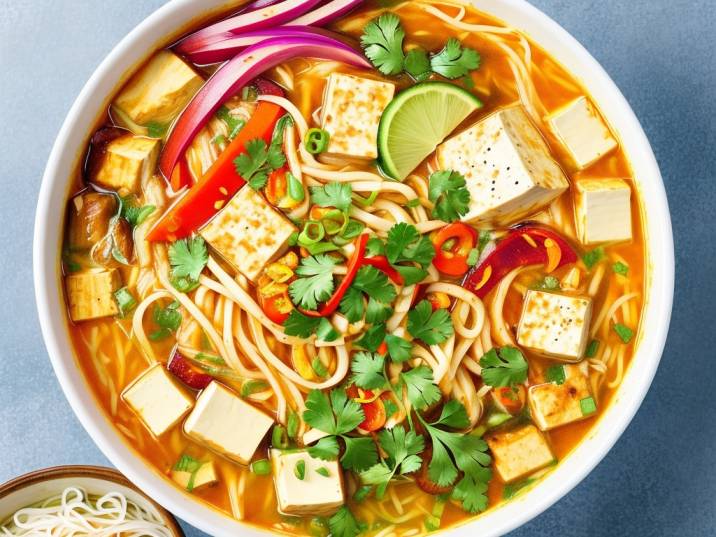If you’re a fan of bold flavors and exotic cuisine, then vegetarian Malaysian laksa is a dish that must be on your culinary bucket list. Bursting with a harmonious blend of aromatic spices, fresh herbs, and wholesome ingredients, this vegan-friendly laksa recipe not only satisfies your taste buds but also offers an array of health benefits. In this blog post, we will explore the nutritional advantages of laksa, provide an easy-to-follow vegetarian Malaysian laksa recipe, essential tips for preparation, serving suggestions, and even recommend some Amazon products to enhance your cooking experience.
[This post may contain affiliate links. What does that mean to you? Well, if you click on a product and make a purchase, I may get some compensation from you at no charge. If you want to read the boring stuff my full disclosure can be found here.]
Health Benefits of Laksa:
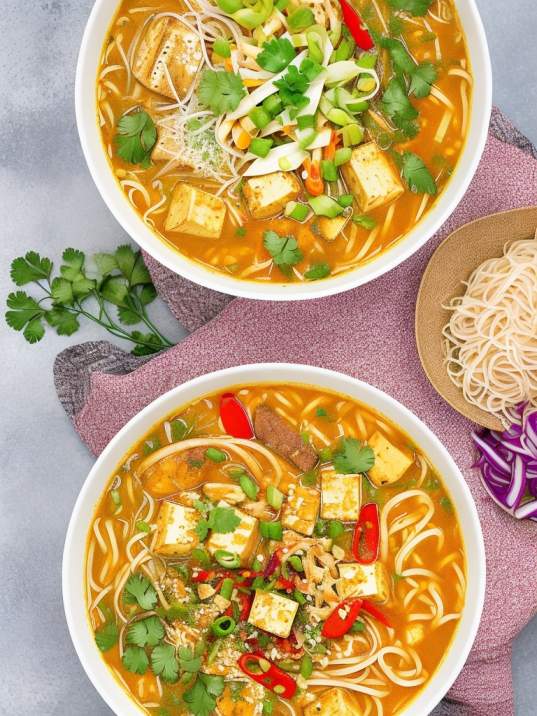
Vegetarian Malaysian laksa is not only a treat for your taste buds but also a nutritious delight. Here are some health benefits associated with its key ingredients:
- Rich in Immune-Boosting Lauric Acid: The creamy coconut milk used in laksa is not only indulgent but also offers a nutritional advantage. It contains lauric acid, a medium-chain fatty acid known for its antiviral, antibacterial, and antifungal properties. Consuming coconut milk in laksa can help support the immune system and ward off harmful pathogens, making it a comforting dish during cold and flu seasons.
- Anti-Inflammatory Properties of Turmeric: The vibrant yellow hue of laksa comes from the addition of turmeric, which contains an active compound called curcumin. Curcumin has potent anti-inflammatory properties, making laksa a beneficial dish for those dealing with inflammatory conditions like arthritis or joint pain. Regular consumption of turmeric can help reduce inflammation and support overall joint health.
- Digestive Support from Lemongrass: Lemongrass, a common ingredient in laksa, not only adds a refreshing citrusy aroma but also provides digestive benefits. It is rich in essential oils that aid in digestion and alleviate bloating and indigestion. The soothing properties of lemongrass can also help calm an upset stomach and promote a healthy digestive system.
- Protein-Packed Tofu for Sustained Energy: The inclusion of tofu in vegetarian laksa ensures a plant-based source of protein. Tofu is rich in essential amino acids, which are crucial for building and repairing tissues in the body. The protein content in tofu also helps maintain steady energy levels, making laksa a satisfying and nourishing meal for vegetarians and vegans.
- Antioxidant-Rich Vegetables for Cellular Health: Laksa’s medley of vegetables, such as bean sprouts, carrots, and snow peas, contributes to its nutritional prowess. These colorful vegetables are packed with vitamins, minerals, and antioxidants that protect the body’s cells from oxidative stress. Regularly consuming antioxidant-rich foods can support overall health and reduce the risk of chronic diseases.
By incorporating these health-promoting ingredients in your vegetarian Malaysian laksa, you not only treat your taste buds to a delightful experience but also nourish your body with a variety of beneficial nutrients. Embrace the goodness of laksa as a flavorsome way to enhance your well-being while savoring the exotic tastes of Malaysia.
Number of Servings: 4
Preparation Time: 15 minutes
Cooking Time: 25 minutes
Total Time: 40 minutes
Total Calories: 400 kcal per serving
Cuisine Type: Malaysian
Course Type: Main Course
Here are the product recommendations for the Vegetarian Malaysian Laksa Recipe:
- Vegetarian Laksa Paste: A must-have for an authentic flavor profile, this vegetarian laksa paste adds depth and complexity to your laksa broth.
- Premium Coconut Milk: Ensure richness and creaminess with high-quality coconut milk, elevating the taste and providing immune-boosting lauric acid.
- Rice Noodles: These gluten-free rice noodles are the perfect base for your laksa, absorbing the flavors while maintaining a satisfying texture.
- Organic Vegetable Broth: Enhance the taste of your laksa with organic vegetable broth, creating a nutritious and flavorful foundation for your dish.
Nutrition Facts (per serving):
| Minerals | Quantity |
|---|---|
| Calories | 400 kcal |
| Fat | 23g |
| Cholesterol | 0mg |
| Sodium | 800mg |
| Carbohydrates | 40g |
| Protein | 15g |
| Calcium | 150mg |
| Iron | 5mg |
| Potassium | 500mg |
| Vitamin D | 0mcg |
| Vitamin A | 1000IU |
| Vitamin C | 8mg |
Ingredients:
- 200g rice noodles
- 400ml coconut milk
- 200g firm tofu, cubed
- 2 tablespoons vegetable oil
- 1 onion, finely chopped
- 3 cloves garlic, minced
- 1 thumb-sized piece of ginger, grated
- 1 stalk lemongrass, bruised and chopped
- 2 tablespoons laksa paste (ensure it’s vegetarian)
- 1 tablespoon turmeric powder
- 500ml vegetable broth
- 100g bean sprouts
- 2 spring onions, sliced
- Fresh cilantro and lime wedges for garnish
- Salt and pepper to taste
Instructions:
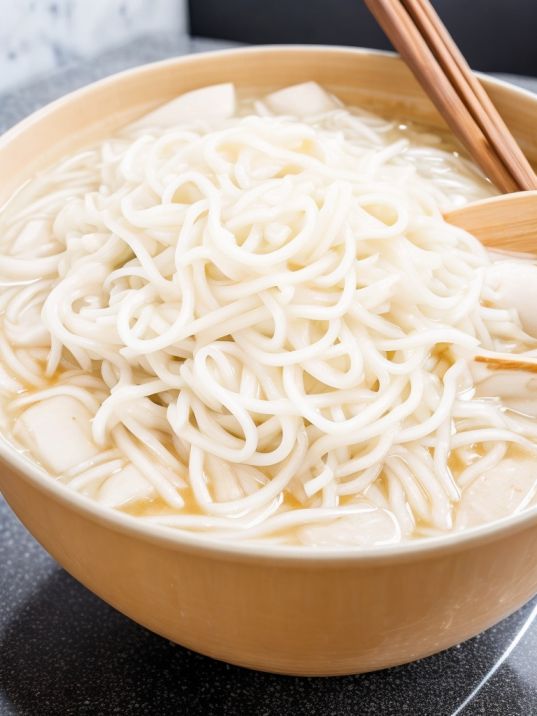
Prepare the rice noodles according to package instructions. Drain and set aside.
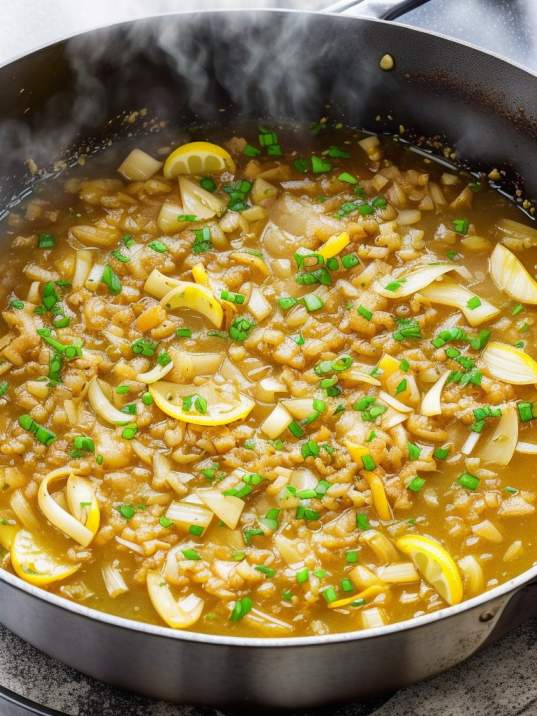
2. In a large pot, heat the vegetable oil over medium heat. Add the chopped onion, garlic, ginger, and lemongrass. Sauté until the onions are soft and translucent.
3. Stir in the vegetarian laksa paste and turmeric powder, cooking for another 2 minutes to release the flavors.
4. Add the coconut milk and vegetable broth, stirring well to combine. Bring the mixture to a gentle simmer.
5. Add the cubed tofu and let the laksa simmer for 10-15 minutes, allowing the flavors to meld together.
6. Season with salt and pepper according to your taste preferences.
7. Divide the cooked rice noodles among four serving bowls.
8. Ladle the laksa broth over the noodles, making sure to distribute the tofu and vegetables evenly.
9. Top each bowl with bean sprouts, sliced spring onions, fresh cilantro, and a lime wedge.
10. Serve hot and enjoy your homemade vegetarian Malaysian laksa!
Serving Suggestions Vegetarian Malaysian Laksa Recipe:
For an authentic experience, serve the laksa with a side of vegetarian spring rolls or crispy tofu satay. To add an extra kick of flavor, you can also offer garnishes like fried shallots, chopped red chilies, or a drizzle of soy sauce.
Also Checkout these Recipes-
- Deliciously Vegan: Jamaican Corn Soup with Dumplings Recipe
- A Healthy Delicious and Nutritious Soya Bean Dal Recipe
FAQs (Frequently Asked Questions)
1. What is laksa broth made of?
Laksa broth is typically made from a base of coconut milk, vegetable or seafood broth, and a blend of aromatic spices such as lemongrass, galangal, turmeric, and chili.
2. What gives laksa its flavor?
Laksa’s flavor comes from the combination of spices, herbs, and the rich creaminess of coconut milk. Key ingredients like lemongrass and turmeric contribute to its distinctive taste.
3. What does Malaysian laksa taste like?
Malaysian laksa boasts a harmonious blend of savory, spicy, and tangy flavors. It is aromatic and rich, with a delightful creaminess from coconut milk.
4. What is the difference between laksa and red curry paste?
While both laksa and red curry paste share some similar ingredients like chili and lemongrass, laksa is more complex with additional spices, whereas red curry paste is focused on the chili flavor.
5. What country is laksa from?
Laksa is a popular dish in Southeast Asia, particularly associated with Malaysia, Singapore, and Indonesia.
6. Why is laksa healthy?
Laksa can be a healthy dish due to its nutritious ingredients like vegetables, tofu, and aromatic spices, which offer antioxidant and anti-inflammatory benefits.
7. What is another name for laksa?
In some regions, laksa may also be known as “curry laksa” or simply “spicy noodle soup.”
8. What is the difference between laksa and curry laksa?
“Laksa” and “curry laksa” are often used interchangeably, but “curry laksa” may refer to a spicier version of laksa that includes curry flavors.
9. What is laksa spice blend?
The laksa spice blend typically includes ingredients like dried chili, turmeric, coriander, cumin, and candlenuts, among others, to create the dish’s signature flavor.
10. What is the best laksa in Malaysia?
The “best” laksa is subjective and can vary from region to region. Different cities or towns in Malaysia may have their own unique and celebrated versions of laksa.
Conclusion:
With its explosion of flavors and healthful ingredients, the vegetarian Malaysian laksa recipe is sure to become a family favorite. Whether you’re a seasoned chef or a novice in the kitchen, this recipe is easy to follow and promises a satisfying dining experience. So, gather your ingredients, embrace the culinary adventure, and indulge in the goodness of a hearty bowl of laksa, knowing you’re treating your taste buds and body to a wholesome, vegan delight.
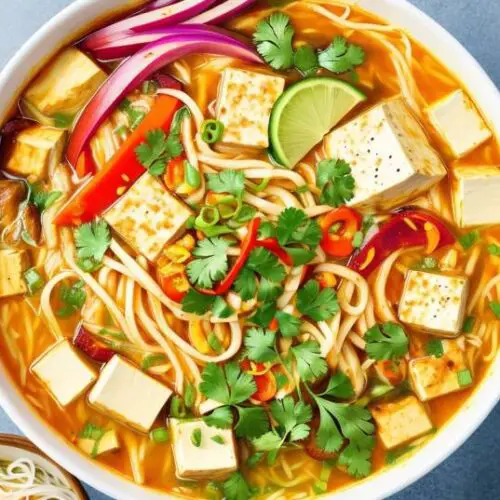
Vegetarian Malaysian Laksa Recipe: A Nutritious Delight
Ingredients
- 200 g rice noodles
- 400 ml coconut milk
- 200 g firm tofu, cubed
- 2 tablespoons vegetable oil
- 1 onion, finely chopped
- 3 cloves garlic, minced
- 1 thumb-sized piece of ginger, grated
- 1 stalk lemongrass, bruised and chopped
- 2 tablespoons laksa paste (ensure it's vegetarian)
- 1 tablespoon turmeric powder
- 500 ml vegetable broth
- 100 g bean sprouts
- 2 spring onions, sliced
- Fresh cilantro and lime wedges for garnish
- Salt and pepper to taste
Instructions
- Prepare the rice noodles according to package instructions. Drain and set aside.
- In a large pot, heat the vegetable oil over medium heat. Add the chopped onion, garlic, ginger, and lemongrass. Sauté until the onions are soft and translucent.
- Stir in the vegetarian laksa paste and turmeric powder, cooking for another 2 minutes to release the flavors.
- Add the coconut milk and vegetable broth, stirring well to combine. Bring the mixture to a gentle simmer.
- Add the cubed tofu and let the laksa simmer for 10-15 minutes, allowing the flavors to meld together.
- Season with salt and pepper according to your taste preferences.
- Divide the cooked rice noodles among four serving bowls.
- Ladle the laksa broth over the noodles, making sure to distribute the tofu and vegetables evenly.
- Top each bowl with bean sprouts, sliced spring onions, fresh cilantro, and a lime wedge.
- Serve hot and enjoy your homemade vegetarian Malaysian laksa!
